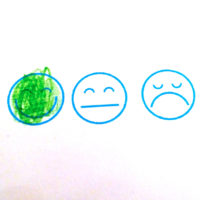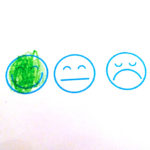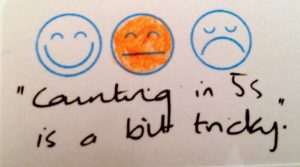My two children go to a lovely infant school that is keen on learning. Each child at the school has a Learning Journey book which display their work, interesting comments they have made about what they are doing, comments from the teachers, next steps for their learning, and so on. They are a wonderful record of the children’s progress. The school also uses the wide-spread ‘traffic light’ sticker system in these Learning Journey books, which children colour in to show how they feel about a particular piece of learning: a happy face, a neither/nor face, and a sad face. Here are a couple of my daughter’s traffic light stickers from year 1.
Being a learning-aware mummy, as much as a doting one, I started to look at how my children described themselves as learners through these simple emoticons. Last year when The Girl Child was in Yr 1 I noticed that she had coloured in a lot of sad faces on her traffic light stickers. I wondered why she was colouring in the sad face, when what I was looking at were near perfect pieces of performance with lots of accolades from her teacher. So we talked about why she showed herself to be sad, despite her teacher being so happy! What emerged was interesting and a little worrying. In colouring in the sad face Girl Child was conveying as well as she could, given the limitations of the scale, how she felt…downcast, worried, just not right…. But further probing led me to realise that what she was really conveying was that the learning was tricky, too hard and that she had been unsure or in some cases bored. The worry here is that she was beginning to link hard or tricky with downheartedness because that’s what the scale suggested. As a result of the conversation she has moderated how she fills in the stickers and is more likely to put a happy face (for when something is easy) or a middle face for when she is being stretched. She uses the sad face mostly for too boring!
The Boy Child, who is 4, uses happy faces all the time – he almost never chooses anything else because he is one of those children who are happy all the time! It would never occur to him to choose anything else and I don’t think he has any concept at the moment of learning stretch – he is asked to do something and he does it to the best of his ability and is mostly happy with the outcome.
When Boy Child, Girl Child and I were all looking at Girl Child’s learning journey book from Year 2, he noticed and commented that the Girl Child doesn’t always colour in the happy face and that this means she isn’t happy (he says this with a typical note of empathy for his big sister). I had to explain that happy or sad or middle faces on the stickers aren’t about whether you are feeling happy that day generally, but how you feel about the learning you have done. He has not yet made the jump from emotional happiness to learning happiness (or otherwise).
So what are we as educationalists or parents to make of this; to learn from this? We need to ask ourselves:
- What we are wanting from such stickers?
- What’s their real purpose?
- What can or do they tell us?
- What do the children make of them?
- Do they know what they are for?
- What should we do with the information they provide?
They are of course a simple meta-cognitive tool, since the children are being expected to reflect on their learning, and of course you can’t do that without letting your feelings sneak in. But are we really tracking the right thing here and are we tracking it correctly? Surely we don’t want children to equate tricky with sadness.
As well as being an immediate record for the child to note their experience of learning in the moment, we should also be looking at them for a wider picture of how the child is feeling and coping with learning in general. Unexpected juxtapositions of traffic light faces, such as the Girl Child’s case of sad face set against perfect performances (and even the Boy Child’s permanently happy faces, no matter the task), need to be noticed and talked about.
So here’s a challenge…what sort of scale or set of images would better fit the bill? Should we put one in for boring? Should we put happy faces in the middle for when the stretch is just right…the Goldilocks stretch….? Should we show a brain in the head going hot but the face still smiling? What sort of emoticons would help children to link tricky learning with positive emotions; to normalise tricky?
Have a go. It’s an intriguing challenge and worthy of some learning enquiries. And if you have already cracked it please share your ideas to help others learn.




No comments yet.